深圳小学英文二年级
沪教牛津版(深圳用)英语二年级上册期末Unit1-Unit3重点单词与句子课件
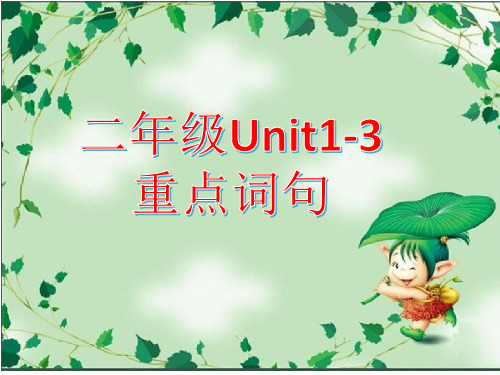
不,我是Kitty.
Are you seven?
你7岁吗?
No,I'm nine.
不,我9岁。
Are you tall?
你高吗?
No,I'm short.
不,我是矮的。
Let’s read
Let’s read
Let’s read
Let’s read
Let’s read
fast strong
slow clever
I’m big. You’re small.
Yes, you’re bigll. You’re short.
(我很高。你很矮。)
I’m thin. You’re fat.
(我很瘦。你很胖。)
I’m a girl. You’re a boy.
--I’m fine.Thank you.
(我很好。谢谢.)
I’m very well.Thank you.
(我很好。谢谢。)
--How are you? (你好吗?)
Not bad. (还不错。) Just so so. (一般般。) I’m great. (我很好。) I’m good. (我很好。)
A
c ɑ
E b
e
CD
F d Bf
Who is he? 他是谁? --He's Eddie.
Who is she? 她是谁? --She's Alice.
Let’s play Look and say 看词请大声读出来
five
two
four
nine
three
seven
ten nine one
(完整)深圳市小学一至六年级英语单词表
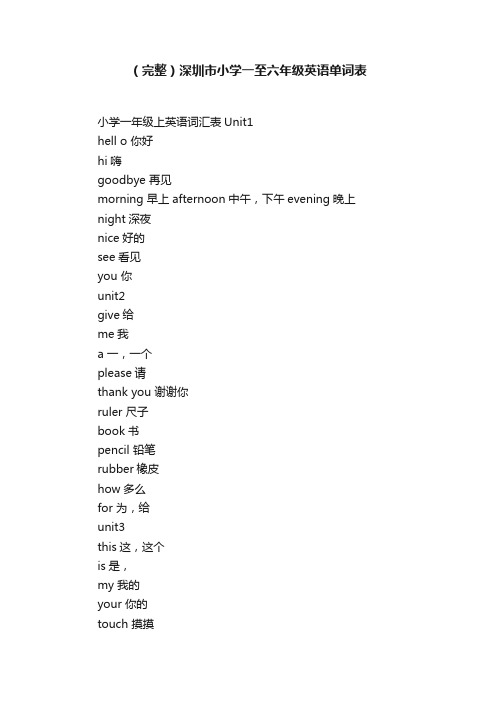
(完整)深圳市小学一至六年级英语单词表小学一年级上英语词汇表Unit1hell o 你好hi嗨goodbye 再见morning 早上afternoon中午,下午evening晚上night深夜nice好的see看见you 你unit2give给me我a 一,一个please请thank you 谢谢你ruler 尺子book书pencil 铅笔rubber橡皮how多么for 为,给unit3this这,这个is是,my 我的your 你的touch 摸摸not 不是face脸mouth嘴巴nose 鼻子eye 眼睛ear 耳朵cute 可爱的can会,能unit 4I 我you 你what什么fl ower花house房子sing 唱歌dance 跳舞read阅读draw画画Unit5who 谁she她he他grandfather爷爷grandmother 奶奶father 父亲mother母亲yes 是no 不mummy妈妈daddy爸爸sister姐,妹brother 兄,弟baby 宝贝finger手指unit 6look看tall高的thin 瘦的fat肥的short矮的classmate同学friend 朋友unit 7how many多少one 一two 二three三four 四five 五six六seven七eight八nine 九ten十paper纸张rabbit兔子let’s 让我们unit8appl e苹果pear梨peach桃子orange橘子like喜欢them他们(宾格)supermarket超市unit 9may 可以have 有,吃,喝help 帮助hamburger 汉堡包pizza披萨cake蛋糕pie 派banana香蕉soup 汤at 在什么地方snack bar小吃部,小卖部unit 10farm农场that那,那个peep 鸡叫声moo 牛叫声chick小鸡duck鸭子cow 奶牛pig 猪oink猪叫声quack 鸭叫声it’s它是(=it is)cut 切stick 粘zoo 动物园there’s在什么地方有bear 熊tiger老虎monkey猴子panda熊猫unit 12col our =col or颜色red 红色的blue蓝色的yellow 黄色的green绿色的orange 橘红色brown棕色的kite风筝sky天空up and d own 又上又下flying very high飞得很高小学一年级下英语词汇表Unit 1see 看见frog 青蛙rabbit 兔子bee 蜜蜂bird 鸟Unit 2listen 听hear 听见sheep 绵羊Unit 3smell 闻taste 尝rice 米饭soup 汤egg 蛋noodles 面条help 帮助stand up 站起来fl ower 花Unit 4toy 玩具like 喜欢ball 球doll玩具娃娃kite 风筝bicycle 自行车toy shop 玩具店super 超级的Unit 5food 食物sweet 糖果,甜的jelly 果冻ice cream 冰淇淋biscuit 饼干teatime 茶点时间for 给and 和sorry 对不起,抱歉very much 非常Unit 6drink 饮料water 水juice 果汁milk 牛奶birthday 生日party 派对,聚会happy 快乐的song 歌曲Unit 7season 季节spring 春天warm 温暖的summer 夏天hot 热的outsid e 在外面in 在....里面cool 凉爽的Unit 8how 怎么样,如何weather 天气cloudy 多云的sunny 阳光美眉的rainy 有雨的,多雨的windy 有风的,多风的go 去1to 到,去beach 沙滩Unit 9clothes 衣服need 需要new 新的dress 连衣裙shorts 短裤blouse 女式衬衫Unit 10activity 活动ride 骑skip 跳绳play 玩,踢(球)fly 放(风筝),飞playtime 游戏时间football 足球rope 绳子Unit 11new year 新年gift 礼物card 贺卡,卡片firecracker 鞭炮,爆竹firework 烟花,烟火make 做,制作write 写fold 折shopping 购物Unit 12boy 男孩wolf 狼(复数wolves)farmer 农夫come 来where 哪里bad 坏的poor 可怜的,穷的tell 说,告诉lie 说谎,谎言run away 逃跑,跑开小学二年级上英语词汇表Unit 1 good 好的morning 早晨today 今天very well 很好,非常好ant 蚂蚁bear 熊Unit 2tall 高的short 矮的boy 男孩girl 女孩big 大的small 小的Unit 3sorry 对不起,请原谅elephant 大象Unit 4swim 游泳run 跑write 书写,写字fly 飞,飞翔ride a bicycle 骑自行车Unit 5family 家庭,家brother 哥哥,弟弟sister 姐姐,妹妹friend 朋友young 年轻的insect 昆虫jellyfish 水母Unit 6hair 头发head 头your 你的long 长的now 现在look 看has 有Unit 7 palyground 游戏场slide 滑梯swing 秋千seeswa 跷跷板nightingale 夜莺Unit 8room 房间put 放the 这in 在...里面bag 包box 箱子,盒子on 在...上面chair 椅子desk 书桌look at 看pencil case 铅笔盒work 工作,干活sleep 睡觉Unit 9dinner 正餐,晚餐ready 准备plate 盘子,碟子chopsticks 筷子bowl 碗spoon 调羹queen bee 蜂王,蜂后fly around 飞来飞去run around 跑来跑去Unit 10sky 天空moon 月亮bright 明亮的sun 太阳star 星snake 蛇king 国王Unit 11forest 森林fox 狐狸meat 肉类hippo 河马grass 草wild 野生的animal 动物cute 可爱的so 这么,那么,所以d ove 鸽子swan 天鹅Unit 12street 大街,街道don’t =d o not 不要pick 摘,采climb 爬tree 树cut 切,割,剪nice 友好的beautiful 美丽的cry 哭泣小学二年级下英语词汇表Unit 1are 是brown 棕色的,褐色的white 白色的black 黑色的Unit 2feel 感觉,摸起来,摸touch 触摸,碰hard 坚硬的soft 软的,柔软的happy 开心的,快乐的guess 猜pencil case 铅笔盒open 打开,开watch 手表Unit 3train 火车,列车ship 大船car 小汽车bus 公共汽车besid e 在....旁边wind ow 窗户can't 不能Unit 4thing 东西,物running 跑步skating 滑冰,滑板hopping 单脚跳行riding 驾驶,骑skate 滑skipping 跳绳flying 飞翔swimming 游泳too 太,也let's 让我们together 在一起,共同Unit 5woul d like 愿意,喜欢some 一些salad 色拉sure 当然fish 鱼,鱼肉chicken 鸡nice 令人愉快的Unit 6zebra 斑马giraffe 长颈鹿snake 蛇elephant 大象lion 狮子toy shop 玩具店toy 玩具Unit 7autumn 秋天cool 凉爽的winter 冬天col d 寒冷的fly a kite 放风筝eat 吃fruit 水果sleeping 睡觉Unit 8traffic 交通rule 规则,规章light 灯,电灯stop 停止,停下go 去,走2wait 等,等待Unit 9sweater 毛衣,线衣shirt 衬衫coat 外套,大衣trousers 裤子Unit 10play yo-yo 玩溜溜球play cards 打牌play football 踢足球Unit 11Teacher’Day 教师节teacher 教师today 今天September 九月idea 想法,主意card 卡片,贺卡ball oon 气球bl ow 吹,吹气tie 系,绑Unit 12go out 外出hungry 饥饿thirsty 口渴的tired 疲倦的,疲劳的house 房屋,房子want 想要,要milk 牛奶bread 面包want to 想做(某事)bed 床little 小的小学三年级上英语词汇表Unit 1hell o 你好I 我Miss 小姐Hello. 你好。
牛津深圳版英语二年级上下册单词汇总打印版

中文英文音标test 1test 2test 3test 4好的good[DZʊd]晚上;傍晚evening[ɑiːvnǺŋ]夜晚night[naǺt]一天;一日day[deǺ]妈妈mum[mȜm]今天today[təɑdeǺ]很好;非常好very well蚂蚁ant[ænt]熊bear[beə(r)]高的tall[tǤəl]矮的short[ʃǤət]男孩boy[bǤǺ]女孩girl[DZǬəl]不;不是no[nəʊ]对yes[jes]名字name[neǺm]对不起;请原谅sorry[ɑsǢri]七seven[ɑsevn]八eight[eǺt]九nine[naǺn]十ten[ten]大象elephant[ɑelǺfənt]游泳swim[swǺm]跑run[rȜn]书写;写字write[raǺt]飞;飞翔fly[flaǺ]骑自行车ride a bicycle不能;不会can't[kɑənt]长颈鹿giraffe[dȢəɑrɑəf]家;家庭family[ɑfæməli]哥哥;弟弟brother[ɑbrȜðə(r)]姐姐;妹妹sister[ɑsǺstə(r)]朋友friend[frend]年轻的young[jȜŋ]老的old[əʊld]坤荣insect[ɑǺnsekt]水母jellyfish[ɑdȢelifǺʃ]头发hair[heə(r)]投head[hed]你的your[jǤə(r); jə(r)]长的long[lǢŋ]现在now[naʊ]看look[lʊk]袋鼠kangaroo[ɕkæŋDZəɑruə]狮子lion[ɑlaǺən]有has[hæz]运动场,游乐场playground[ɑpleǺDZraʊnd]滑梯slide[slaǺd]秋千swing[swǺŋ]跷跷板seesaw[ɑsiə sǤə]夜莺nightingale[ɑnaǺtǺŋDZeǺl]房间room[ruəm; rʊm]放put[pʊt]表示特指the[ðə; ði; ðiː]包bag[bæDZ]爸爸dad[dæd]盒子;箱子box[bǢks]在……上面on[Ǣn]椅子chair[tʃeə(r)]书桌desk[desk]小汽车car[kɑə(r)]看look at铅笔盒;铅笔袋pencil case公牛ox[Ǣks]劳动;干活work[wǬək]睡觉sleep[sliəp]正餐;晚餐dinner[ɑdǺnə(r)]准备好ready[ɑredi]盘子;碟子plate[pleǺt]筷子chopsticks['tʃǢpstǺks]碗bowl[bəʊl]匙;调羹spoon[spuən]蜂王;蜂后queen bee飞来飞去fly around跑来跑去run around天空sky[skaǺ]月亮moon[muən]明亮的bright[braǺt]太阳sun[sȜn]星star[stɑə(r)]蛇snake[sneǺk]国王king[kǺŋ]森林forest[ɑfǢrǺst]狐狸fox[fǢks]肉类meat[miət]河马hippo[ɑhǺpəʊ]野生的wild[waǺld]动物animal[ɑænǺml]可爱的cute[kjuət]哇;呀wow[waʊ]这么;那么so[səʊ]鸽子dove[dȜv]天鹅swan[swǢn]大街;街道street[striːt]不要(=do not)don't[dəʊnt]do not采;摘pick[pǺk]花flower[ɑflaʊə(r)]爬climb[klaǺm]树tree[triə]切;割;剪cute[kȜt]令人愉快的;友好的nice[naǺs]美丽的beautiful[ɑbjuətǺfl]哭;哭泣cry[kraǺ]牦牛yak[jæk]斑马zebra[ɑzebrə; ɑziəbrə]是;就是are[ɑ:(r)]他们;她们;它们they[ðeǺ]棕色的;褐色的brown[braʊn]白色的white[waǺt]黑色的black[blæk]和;与and[ænd]摸;摸起来feel[fiəl]触摸;碰touch[tȜtʃ]坚硬的hard[hɑəd]软的;柔软的soft[sǢft]感到快乐的happy[ɑhæpi]生日birthday[ɑbǬəθdeǺ]给for[fə(r); fǤː(r)]猜测guess[DZes]铅笔盒;铅笔袋pencil case打开open[ɑəʊpən]哇、呀wow[waʊ]表;手表watch[wǢtʃ]火车;列车train[treǺn](大)船ship[ʃǺp]小汽车;轿车car[kɑə(r)]公共汽车;巴士bus[bȜs]听listen[ɑlǺsn]在……旁边beside[bǺɑsaǺd]窗户window[ɑwǺndəʊ]在……外面outside[ɕaʊtɑsaǺd]不能can't[kɑːnt]东西;物thing[θǺŋ]do的ing形式,做doing[ɑduəǺŋ]run的ing形式,跑步running[ɑrȜnǺŋ] skate的ing形式)滑;滑冰skating[ɑskeǺtǺŋ] hop的ing形式单脚跳行hopping[ɑhǢpǺŋ]ride的ing形式,骑;驾驶riding[ɑraǺdǺŋ]滑滑板;溜冰skate[skeǺt]单脚跳行hop[hǢp]skip的ing形式,跳绳skipping[skǺpǺŋ]fly的ing形式,飞;飞翔flying[ɑflaǺǺŋ]s w i m的ing形式swimming[swǺŋ]也too[tuə]让我们let's[lets]在一起;共同together[təɑDZeðə(r)]表示愿意,喜欢would like一些some[səm; sȜm](生吃的)蔬菜色拉salad[ɑsæləd](表示同意)当然sure[ʃʊə(r); ʃǤə(r)](= do not)don't[dəʊnt]鱼;鱼肉fish[fǺʃ]鸡;鸡肉chicken[ɑtʃǺkǺn]令人愉快的nice[naǺs]美味的yummy[ɑjȜmi]斑马zebra[ɑzebrə; ɑziəbrə]长颈鹿giraffe[dȢəɑrɑəf]蛇snake[sneǺk]大象elephant[ɑelǺfənt]狮子lion[ɑlaǺən]玩具店toy shop玩具toy[tǤǺ]骑自行车ride a bicycle放风筝fly a kite堆雪人make a snowmaneat[iət]水果fruit[fruət]s l eep的ing形式,睡觉sleepig['sliəpǺŋ]交通traffic[ɑtræfǺk]规则;规章rule[ruəl]等;电灯light[laǺt]停止;停下shop[ʃǢp]去;走go[DZəʊ]等;等待wait[weǺt]毛衣;绒衣sweater[ɑswetə(r)](男式)衬衫shirt[ʃǬət]外套;大衣coat[kəʊt]裤子trousers[ɑtraʊzəz]寒冷的cold[kəʊld]温暖的warm[wǤəd](狗叫声)汪汪woof[wʊf]玩溜溜球pay yo-yo打牌pay cards踢足球play football读书日book day今天today[təɑdeǺ]许多 a lot of有趣的interesting[ɑǺntrəstǺŋ]书签bookmark[ɑbʊkmɑək]想法;注意idea[aǺɑdǺə]系;绑tie[taǺ]关于about[əɑbaʊt]机器人robot[ɑrəʊbǢt]熊爸爸papa bear熊妈妈mama bear外出go out感到饿的hungry[ɑhȜŋDZri]口渴的thirsty[ɑθǬəsti]房屋;房子house[haʊs]要,想要want[wǢnt]牛奶milk[mǺlk]面包bread[bred]想做(某事)want to床bed[bed]小的little[ɑlǺtl]。
深圳小学二年级(上)Book 3 知识点总复习
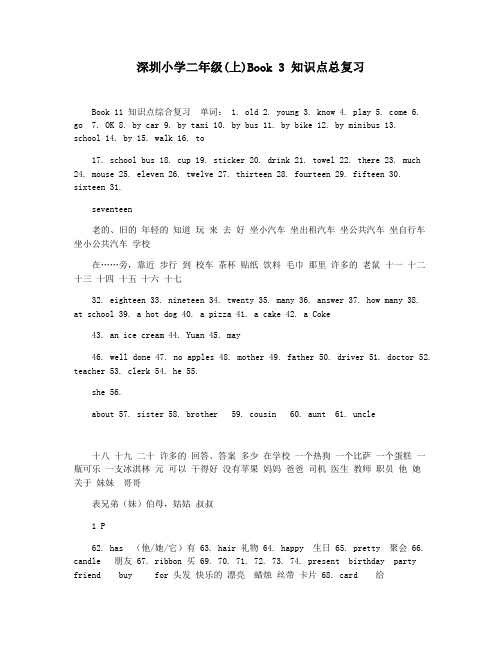
深圳小学二年级(上)Book 3 知识点总复习Book 11 知识点综合复习单词: 1. old 2. young 3. know 4. play 5. come 6. go 7. OK 8. by car 9. by taxi 10. by bus 11. by bike 12. by minibus 13.school 14. by 15. walk 16. to17. school bus 18. cup 19. sticker 20. drink 21. towel 22. there 23. much 24. mouse 25. eleven 26. twelve 27. thirteen 28. fourteen 29. fifteen 30. sixteen 31.seventeen老的、旧的年轻的知道玩来去好坐小汽车坐出租汽车坐公共汽车坐自行车坐小公共汽车学校在……旁,靠近步行到校车茶杯贴纸饮料毛巾那里许多的老鼠十一十二十三十四十五十六十七32. eighteen 33. nineteen 34. twenty 35. many 36. answer 37. how many 38.at school 39. a hot dog 40. a pizza 41. a cake 42. a Coke43. an ice cream 44. Yuan 45. may46. well done 47. no apples 48. mother 49. father 50. driver 51. doctor 52. teacher 53. clerk 54. he 55.she 56.about 57. sister 58. brother 59. cousin 60. aunt 61. uncle十八十九二十许多的回答、答案多少在学校一个热狗一个比萨一个蛋糕一瓶可乐一支冰淇林元可以干得好没有苹果妈妈爸爸司机医生教师职员他她关于妹妹哥哥表兄弟(妹)伯母,姑姑叔叔1 P62. has (他/她/它)有 63. hair 礼物 64. happy 生日 65. pretty 聚会 66. candle 朋友 67. ribbon 买 69. 70. 71. 72. 73. 74. present birthday party friend buy for 头发快乐的漂亮蜡烛丝带卡片 68. card 给二、短语1. how old看多大了 2. come in请进 3. all right好吧 4. dance with和……一起跳舞 5. jump with和……一起跳跃 6. by bike骑自行车 7. come to school来学校 8. walk to school走路来学校 9. run to school跑步来学校 10. fly to school飞到学校三、句子21. Can I help you? 22. Let's play!23. How old are you? 24. I'm old. 25. I'm young.26. Come in, please. 27. I can sing with Kate. 28. I can dance with Jen. 29. What can you see? 30. I can see a taxi.31. How do you come to school, Pat? 32. I come to school by school bus. 33. Jim walks to school every day.11. there's 12. there're 13. what's in 14. two drinks15. a birthday party 16. a birthday cake 17. a birthday present 18. a birthday card 19. buy a present 20. Happy birthday!要我帮忙吗?我们一起玩吧!你多大了?我是老的。
深圳小学二年级上期英语单词表(Koko爱英语)

十一 十二 十三 十四 十五 十六 十七
eighteen nineteen twenty many how many answer
十八 十九 二十 许多的 多少…… 答案;回答
1/2
Unit 6 Shopping
teacher clerk he she
教师 职员 他 她
Unit 8 My family
sister brother cousin aunt
姐;妹 兄;弟 堂/表兄弟,堂/表姐妹 伯母,舅母,婶母,姑,姨
uncle has hair
叔,伯,舅,姑父,姨夫 有 头发
Unit 9 A birthday party
happy y candle ribbon card
快乐的,高兴 漂亮的 蜡烛 丝带 卡片;名片
present birthday party friend buy
2/2
礼物 生日 聚会,晚会 朋友 买
学校 校车 靠近,在……旁 步行 到;对;向
Unit 3 In my school bag
cup sticker drink towel
茶杯 (背面)又粘胶的标签 饮料 毛巾
there
there is/are
那里 (表示存在)有 许多的 非常
much very much
Unit 4 In my classroom
Unit 1 My age
old play OK come
老的;旧的 玩 (口语)好 来
come in all right know
进来 行,好 知道
Unit 2 Coming to school
牛津深圳版小学英语各年级单词表

牛津深圳版小学英语各年级单词表文稿归稿存档编号:[KKUY-KKIO69-OTM243-OLUI129-G00I-FDQS58-小学一年级上Unit1hello 你好hi嗨goodbye 再见morning 早上afternoon中午,下午evening晚上night深夜nice好的see看见you 你unit2give给me我a 一,一个please请thank you 谢谢你ruler 尺子book书pencil 铅笔rubber橡皮how多么for 为,给unit3this这,这个is是my 我的your 你的touch 摸摸not 不是face脸mouth嘴巴nose 鼻子eye 眼睛ear 耳朵cute 可爱的can会,能Unit 4I 我you 你what什么flower花house房子sing 唱歌dance 跳舞read阅读draw画画Unit5who 谁she她he他grandfather爷爷grandmother 奶奶father 父亲mother母亲yes 是no 不mummy妈妈daddy爸爸sister姐,妹brother 兄,弟baby 宝贝finger手指Unit 6look看tall高的thin 瘦的fat肥的short矮的classmate同学friend 朋友Unit 7how many多少one 一two 二three三four 四five 五six六seven七eight八nine 九ten十paper纸张rabbit兔子let’s 让我们unit8apple苹果pear梨peach桃子orange橘子like喜欢them他们(宾格)supermarket超市Unit 9may 可以have 有,吃,喝help 帮助hamburger 汉堡包pizza披萨cake蛋糕pie 派banana香蕉soup 汤at 在什么地方snack bar小吃部,小卖部Unit 10farm农场that那,那个peep 鸡叫声moo 牛叫声chick小鸡duck鸭子cow 奶牛pig 猪oink猪叫声quack 鸭叫声it’s它是(=it is) cut 切 stick 粘Unit 11zoo 动物园there’s在什么地方有bear 熊tiger老虎monkey猴子panda熊猫Unit 12colour =color颜色red 红色的blue蓝色的yellow 黄色的green绿色的orange 橘红色brown棕色的kite风筝sky天空up and down 又上又下flying very high飞得很高小学一年级下Unit 1see 看见frog 青蛙rabbit 兔子bee 蜜蜂bird 鸟Unit 2listen 听hear 听见sheep 绵羊hen 母鸡Unit 3smell 闻taste 尝rice 米饭soup 汤egg 蛋noodles 面条help 帮助stand up 站起来flower 花Unit 4toy 玩具like 喜欢ball 球doll玩具娃娃kite 风筝bicycle 自行车toy shop 玩具店super 超级的Unit 5food 食物sweet 糖果,甜的jelly 果冻ice cream 冰淇淋biscuit 饼干teatime 茶点时间for 给and 和sorry 对不起,抱歉very much 非常Unit 6drink 饮料water 水juice 果汁milk 牛奶birthday 生日party 派对,聚会happy 快乐的song 歌曲Unit 7season 季节spring 春天warm 温暖的summer 夏天hot 热的outside 在外面in 在....里面cool 凉爽的Unit 8how 怎么样,如何weather 天气cloudy 多云的sunny 阳光美眉的rainy 有雨的,多雨的windy 有风的,多风的go 去to 到,去beach 沙滩Unit 9clothes 衣服need 需要new 新的dress 连衣裙shorts 短裤blouse 女式衬衫Unit 10activity 活动ride 骑skip 跳绳play 玩,踢(球)fly 放(风筝),飞playtime 游戏时间football 足球rope 绳子Unit 11new year 新年gift 礼物card 贺卡,卡片firecracker 鞭炮,爆竹firework 烟花,烟火make 做,制作write 写fold 折shopping 购物Unit 12boy 男孩wolf 狼(复数wolves)farmer 农夫come 来where 哪里bad 坏的poor 可怜的,穷的tell 说,告诉lie 说谎,谎言run away 逃跑,跑开小学二年级上Unit 1good 好的morning 早晨today 今天very well 很好,非常好ant 蚂蚁bear 熊Unit 2tall 高的short 矮的boy 男孩girl 女孩big 大的small 小的Unit 3sorry 对不起,请原谅elephant 大象Unit 4swim 游泳run 跑write 书写,写字fly 飞,飞翔ride a bicycle 骑自行车Unit 5family 家庭,家brother 哥哥,弟弟sister 姐姐,妹妹friend 朋友young 年轻的insect 昆虫jellyfish 水母Unit 6hair 头发head 头your 你的long 长的now 现在look 看has 有Unit 7 playground 游戏场slide 滑梯swing 秋千seesaw 跷跷板nightingale 夜莺Unit 8room 房间put 放the 这in 在...里面bag 包box 箱子,盒子on 在...上面chair 椅子desk 书桌look at 看pencil case 铅笔盒work 工作,干活sleep 睡觉Unit 9dinner 正餐,晚餐ready 准备plate 盘子,碟子chopsticks 筷子bowl 碗spoon 调羹queen bee 蜂王,蜂后fly around 飞来飞去run around 跑来跑去Unit 10sky 天空moon 月亮bright 明亮的sun 太阳star 星snake 蛇king 国王Unit 11forest 森林fox 狐狸meat 肉类hippo 河马grass 草wild 野生的animal 动物cute 可爱的so 这么,那么,所以dove 鸽子swan 天鹅Unit 12street 大街,街道don’t =do not 不要pick 摘,采climb 爬tree 树cut 切,割,剪nice 友好的beautiful 美丽的cry 哭泣小学二年级下Unit 1are 是brown 棕色的,褐色的white 白色的black 黑色的Unit 2feel 感觉,摸起来,摸touch 触摸,碰hard 坚硬的soft 软的,柔软的happy 开心的,快乐的guess 猜pencil case 铅笔盒open 打开,开watch 手表Unit 3train 火车,列车ship 大船car 小汽车bus 公共汽车beside 在....旁边window 窗户can't 不能Unit 4thing 东西,物running 跑步skating 滑冰,滑板hopping 单脚跳行riding 驾驶,骑skate 滑skipping 跳绳flying 飞翔swimming 游泳too 太,也let's 让我们together 在一起,共同Unit 5would like 愿意,喜欢some 一些salad 色拉sure 当然fish 鱼,鱼肉chicken 鸡nice 令人愉快的Unit 6zebra 斑马giraffe 长颈鹿snake 蛇elephant 大象lion 狮子toy shop 玩具店toy 玩具Unit 7autumn 秋天cool 凉爽的winter 冬天cold 寒冷的fly a kite 放风筝eat 吃fruit 水果sleeping 睡觉Unit 8traffic 交通rule 规则,规章light 灯,电灯stop 停止,停下go 去,走wait 等,等待Unit 9sweater 毛衣,线衣shirt 衬衫coat 外套,大衣trousers 裤子Unit 10play yo-yo 玩溜溜球play cards 打牌play football 踢足球Unit 11Teacher’s Day 教师节teacher 教师today 今天September 九月idea 想法,主意card 卡片,贺卡balloon 气球blow 吹,吹气tie 系,绑Unit 12go out 外出hungry 饥饿thirsty 口渴的tired 疲倦的,疲劳的house 房屋,房子want 想要,要milk 牛奶bread 面包want to 想做(某事) bed 床little 小的小学三年级上Unit 1hello 你好I 我Miss 小姐Hello. 你好。
深圳版小学二年级英语下册全册教案
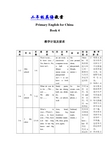
二年级英语教案Primary English for ChinaBook 4教学计划及要求第1课时课题Unit 1 My school 教学目标New words: room, library, hall, music, art, playground Sentence patterns: This is …There is a an …教材分析重点New words: room, library, hall, music, art, playground难点Sentence patterns: This is …There is a an …教具Word cards, picture, tape-recorder教学过程I. Free talkⅡ. Presentation1.Bring in a picture of a school and photos or pictures of thedifferent rooms taught in the Unit.2.( Books closed ) Show the picture of you the school,saying This is my school.Give individual pupils the picture and ask them to repeat the sentence.3.Show the pictures of the different rooms in the school.Say their names and ask the pupils to repeat them after me Then practise by showing a room and asking the pupils to tell me the name.4.Choose a picture and point to something in the picture thepupils know, e. g. a tree, a well-known room and say There’s a/an …Show the picture to individual pupils and ask them to point to the object and repeat the sentence.Point to other known items in the picture and encourage them to make sentences about them.5.Play the Pupil‟s Book Cassette and point to the speechbubble. Ask the pupils to repeat after the beeps.Ⅲ. Practice1.( Books open ) Show Transparency. Point to the places inthe school on the page, saying There’s a classroom, etc.Encourage the pupils to repeat the sentences after you. 2.Introduce the new character, Mike. Explain that Tim isshowing Mike a picture of his school. Teach the pupils the name of the school ( No. 1 Primary School ).教学过程3.Read Tim‟s speech bubble. Get the pupils to point to thecorrect places. Make sentences about the other places using There’s a/an …4.Encourage the pupils to make sentences by using there isa /an…while I point to the places in the picture.5.Get the pupils to look at each of the rooms. Point at anobject in a room and say There’s a …布置作业1.Copybook 12.Workbook 13. Write the newwords on thenotebook.板书设计Unit 1 My schoolwords(picture cards)This is my school.There’s an art room.There’s a library.教学后记1.Teaching new words with motions impresses pupils.ing ‘a’ and ‘an’ should be emphasized.3. Pupils feel hard in pronouncing the words library, hall, and playground.第2课时课题Unit 1 My school教学目标New words: art room, music room, hall, library …Sentence patterns: Welcome to …Is there a …Yes, there is./ No, there isn‟t.New words: art room, music room, hall, library…Sentences: Is there a … Yes, there is. / No, there isn‟t.Word cards, picture, tape-recorderⅠ. Free talkⅡ. PresentationMake a plan of your school with the places marked on it.The plan does not need to have the English names written on it.( Books closed ) Show the pupils a plan of your school with the places marked on it, revising the English names for the places.Point to the plan and ask, for example, Is there a music room?Ask a pupil to come out and point to the place named and say Yes, there is. Ask about a place not in the school, e.g. Is there a swimming pool? Is there a zoo?Then teach No, there isn‟t.4. ( Books open ) Show Transparency. Play the Pupil‟s BookCassette and ask the pupils to repeat the characters‟ words after the beeps.Ⅲ. Practice1.Show Transparency and play the Pupil‟s Book Cassette.Explain that Tim and Pat are visiting Mike‟s school. The Ss listen and follow in their books. Continue to play the cassette and ask the pupils to repeat.2.Show the words in Tim and Pat‟s thought bubbles. Drillthe question form with the pupils by giving them the six word cues one by one and getting the pupils to ask Is there a/an …? For each place in the school.3.Show the words with ticks and crosses in Mike‟s thoughtbubble. Explain that a tick means they should answer Yes, there is. A cross means that they should answer No, there isn’t.4.Divide the class into three groups to role-play Tim, Patand Mike. Get them to chorus the conversation following the order of the word cues in Tim and Pat‟s thought bubbles.1.Copybook 22.Workbook 23.Review whatwe learnedtoday.Unit1 My school Welcome to my school!Is there a …Is there an …Yes, there is./No, there isn’t.1. Practice the sentence with the plans of different school, doing a survey, or drawing a plan of pupils’ ideal school may enable the lesson more interesting.2. Pupils need to be remind to add a ‘a’ in the sentence.第3课时Unit 1 My school教学目标New words: can‟t coolSentence patterns: Come and have a look.Is there a/an …?Yes, there is./ No, there isn‟t. Words and sentence patternsSentence patterns: Is there a/an… Yes, .../ No, … Picture cards, tape-recorderⅠ. Free talkWhat‟s in your classroom?Is there a computer?Yes, there is. / No, there isn‟tWhat‟s on your desk?Is there a pencil case?…Ⅱ. Presentation1.Point to the characters in the pictures and read their speech bubblesaloud. Ask the pupils to point to the speech bubbles as you read them.2.Play the Pupil‟s Book Cassette for the pupils and ask them to saythe sentences after the cassette.3.Explain that the man in the story is the school principal.4.Ask questions about what the boy can do, e. g. Can he sing ?Encourage the pupils to answer Yes, he can./ No, he can‟t.5.Ask the pupils to role-play the story in groups of three and to readthe characters‟ speech bubbles. Some groups may like to come out to the front and act the story.6.You may use Storycards to revise sequence and language of thestory.Ⅲ. Tick ( ) or cross ( )1.Ask the pupils to read the story again. I Read the words in thespeech bubbles with the pupils.2.Demonstrate how to tick or cross the first sentence with the pupilsas an example. If the pupils are not sure of the answer go backand read the story with them again until they find the answer.3.Check answers using Transparency.Ⅳ. SummaryI can sing. I can draw.I can’t sing. I can’t draw.1.Copybook P32.Workbook P33. Review what we learned todayUnit 1 My schoolIs there an art room? Yes, there is. /No, there isn’t.I can’t swim.I can play.1.Pupils have difficulty in understanding ‘come and have a look’, so they need tobe told the meaning and some situations and some practice are needed.2.Pupils have fun in reading the story imitating the record.With the guidance of the teacher, better pupils can retell the story---- feel delighted第4课时Unit 1 My school教学目标The pronunciation of “ou”in the following words: out, around, shout, playgroundsound “ou” in the words: around, shout, playground sound “ou” in the words: around, shout, playgroundPicture cards, tape-recorderⅠ.Free talkWhat‟s in your pencil case?Is there a rubber?Is there a ruler?Yes, there is. /No, there isn‟t.Are there any pencils?Yes, there are. /No, there aren‟t.Ⅱ. Presentation ( E. say the sound and the words.)1.Play the Pupil‟s Book cassette and ask the pupils to listento the sound and the words. Point out the spelling of this sound. It is important that the pupils realize the vowel sound is spelt with two letters. Demonstrate how to make the sound and get the pupils to look a t your face while doing so. Check that the pupils are opening their mouths sufficiently and making the sound correctly.2.Say the words slowly and clearly. Check that the pupilsare saying the sound correctly.3.Point to the pictures and check that the pupils can say thewords without your model.4.Play the Pupil‟s Book Cassette again. Ask the pupils tolisten to the rhyme and to tick the correct picture. Get the pupils to say the rhyme.Ⅲ. More to do. ( Workbook P.4 )1.Ask Ss to look at the first part of the page and listen tothe Workbook Cassette.2.Draw a line to the correct words according to what theyhear on the tape.Tapescript and answers: ou ( mouth, playground )3. Ask Ss to look at the second part of the page. Tell them tolook at the pictures and fill in the blanks in the sentence.What‟s in your school? Is there a library? Yes, there is.What‟s in your school? Is there an art room? No, there isn‟t.1.Copybook P42.Workbook P43. Review what we learned today Unit 1 My school out, around, shout, playground go out run around in the playgroundPupils feel hard to pronounce the word round and shout for they have never learned these words. So more practise is needed. Saying the rhyme with clapping hands for several times make pupils feel more interesting.第5课时Unit 1 My school教学目标Get Ss to be more familiar with the words and the sentence patterns “There be”“Is there a/an …”“Yes, there is/No, …”Words and sentence patterns Is there a/an … Yes, ../No,.. Words and sentence patterns Is there a/an … Yes, ../No,..Word cards, pictures and tape-recorderⅠ. Free talkWhat‟s in your room?Is there a big TV?Is there a computer?Is there a fan?Yes, there is. /No, there is n‟t.Ⅱ. Revision1.Review the wordclassroom, library, hall, music room, art room, playground…2. Choose some students to spell the words, and choose someable students, make sentences with these words.Ⅲ. Presentation ( F. Look and do. P.5)1.Tell the pupils to work in pairs. One should be Student Aand the other one Student B. ask all the pupils who are student A to put up their hands. Repeat with the pupils who are Student B.2.Read the instructions on the page with the pupil. Askthem to turn to pages 60 and 61. point out the different plans Students A and B should look at. Explain that the places on the plans are the same, but the objects are in different places.3.Tell the pupils to put ticks in the correct places in the gridon page 60 or page 61.4.Demonstrate one conversation by having one student Aask, e.g. Is there a fan?Get Student B to answer No, there isn’t. Then have Student A ask Is there a TV? Get Student B to answer Yes, there is. It’s in the classroom.Show the pupils that Student A should tick the box across from classroom and under the TV in the grid.IV. Tell them to take turns to ask and answer questions and to put ticks in their grid according to their partner‟s answers. V. Summary1. Workbook P52. Review what we learned today Unit 1 My school Is there a fan? No, there isn’t.Is there a TV? Yes, there is.It’s in the classroom.第6课时Unit 1 My school教学目标Consolidate all the new words and sentence patterns of Unit 1Part G: Sing the songsThe words and sentence patterns in unit1Sentence patterns in unit1Word cards, picture cards, tape-recorder, projectorI. Free talkWhat‟s the weather like today?Is there a computer in the classroom?Are there any fans in the classroom?How many fans in the classroom?Ⅱ. Revision1.Review the new wordsart room, library, hall, music room, playground, classroom, computer room, music room, around, shout 2. Review sentence patterns.This is my school. There‟s an art room. There‟s a library.Welcome to my school!Is there a library?Yes, there is./ No, there isn‟t.Ⅲ. Sing and play1.Play the Pupil‟s Book Cassette for the pupils to listen tothe song.2.Play the cassette again and tell the pupils to tick thecorrect pictures for the rooms in the first two verses ofthe song.3.Play the cassette again and encourage the pupils to joinin with the words. Then point to one of the rooms shownat the bottom of the page and ask the pupils to sing thenext three verses substituting the name of the room Ipoint to.Ⅳ. Workbook. (P5)1. Ask the pupils to read the speech bubbles in the pictureson the left.2. Then match them to the pictures on the right by writingthe correct letter in the circle.Ⅴ. Summary1.Read partA and partB together.2.Sing the songs again.1.Review the words and Part A,B,C,D,E,F.2.Prepare Unit 2Unit 1 My school There is an art roomIn my school,In my school,There’s an art room in …My school’s cool.第1课时Unit 2 At school (Ⅰ)New words: study, paint, line up, dining hall, eat,drink…Sentence patterns: Let‟s …New words: study, paint, line up, dining hall, drink …Sentence patterns: Let‟s …Word cards, picture, tape-recorderⅠ. Free talkWhat can you do?Can you run?Can you jump?Can you dance?Ⅱ. Presentation1.Revise with the pupils the verbs they learned in Pupil‟sBook Unit 3 (run, dance, jump, sing, read, write). Doactions for run, dance, jump, sing, read and write andhave the pupils repeat the words after you. Thenencourage the pupils to do the actions with you bysaying, for example, Let’s run.2.Teach the new words with actions to demonstrate theirmeanings. For example, open more than one book, andmake notes for study, draw a paintbrush and pretend topaint, get a few pupils to line up, mime eat and drink andgently throw a ball to a pupil, saying Let’s play.3.Drill the new words by saying a word and getting thepupils to do the appropriate action or by doing an action and getting the pupils to say Let’s …4.Show Transparency and play the tape. Ask the pupils torepeat the words in the speech bubbles after the beeps.Do the same with the vocabulary items.Ⅲ. Practice1.Show Transparency. Point to the children on the pagewho are painting. Say Let’s paint. Get the pupils to do the action and join in with them. Let’s line up.2.Point to the other words. Ask the pupils to repeat themafter you and to do the action you have taught them.3.Ask the pupils to work in groups of four. Give a word cuelike study.Nominate one pupil in the group to make a sentence with Let‟s …and to invite Ss to do the action with him or her.3.Copybook 54.Workbook 6 3. Write the new words on the notebook. Unit 2 At schoolwords (picture cards) Let’s study. Let’s paint. Let’s line up.The activity that teacher give orders (say the words) and pupils do actions is good for memorizing the new words and sentence pattern.第2课时Unit 2 At school (Ⅱ)New words: sing, play, study …Sentence patterns: What do you do in the …? We … and …New words: sing, play, study …Sentence patterns: What do you do in the …? We … andWord cards, picture, tape-recorderⅠ. GreetingHow are you today?Is there a library in the school?Can we shout in the library?Ⅱ. Presentation1.Bring in the plan of the school again.2.Point to an appropriate room on the plan. Make sentences about whatthe pupils do in the room. For example, say We study in the classroom.3.Drill the pupils by asking about the different rooms, e.g. What do youdo in the dining hall?Encourage the more able pupils to use morethan one verb by saying And? With rising intonation after they havetold you one thing they do, e.g. S: We eat. T: And? S: We drink.4.Show Transparency and play the tape. Point to the speech bubbles andget the pupils to repeat the sentences after the beeps.Ⅲ. Practice1.Show Transparency and play the tape. The pupils listen and follow intheir books. Continue to play the cassette and ask the pupils to repeat the words after the beeps.2.Show Ss the characters and explain Mike is in Pat‟s school.3.Point to the pictures and ask, for example, what do you do in theplayground? Encourage the pupils to make a sentence about each small picture in the thought bubbles.4.Show the pupils, using the sentences in the speech bubbles, that whenwe talk about more than one thing we can use … and … to link the actions. We can also use …, too to link a sentence to a previous sentence.5.Point to Pat‟s thought bubbles in picture 3. help Ss to link the actionsshown by saying … and … or …, too.6.Ask the pupils to work in pairs to complete the conversation. Thepupils take turns to role-play P and M.1.Copybook 62.Workbook 73. Review what welearned today.Unit 2 At school What do you do in the playground? We line up and sing.We play, too.Enlargement:1.We surf the internet/ play computer game in the computer room.2.We sing and dance/ have a show in the hall.3.We swim in the swimming pool.jump, run, read, write, etc.第3课时Unit 2 At school (Ⅲ)Words: here ,pool, coolSentence patterns “What do you do in the …?”“We … and …”“We play in the …”the sentence patterns of “ What do you do in the …?”the sentence patterns of “ What do you do in the …?”Picture cards, tape-recorderⅠ. GreetingWhat do you do at home?We eat and drink.We play, too.Ⅱ. Presentation1.Point to the characters in the pictures and read their speech bubblesaloud. Ask the pupils to point to the speech bubbles as you readthem.2.Play the Pupil‟s Book Cassette for the pupils and ask them to saythe sentences after the cassette.3.Pupils say the speech bubbles together. And then say them groupby group, see which group is best.4.Ask the pupils to role-play the story in groups of three and to readthe characters‟ speech bubbles. Some groups may like to come outto the front and act the story.e the storycards to revise sequence and language of the story.Ⅲ.Do the part D1.Ask the pupils to read the story again. Read the words in thespeech bubble with pupils and tell them to repeat the sentences.2.Demonstrate how to write a cross in the first one as an example.e Transparency to check the answers.Ⅳ. More to do1.Write the names of the different rooms on the board. Using stripsof paper with the action verbs written on them, ask the pupils to stick a strip of paper under an appropriate room name.2.Ask a pupil about a room, for example, what do you do in themusic room? The pupil makes a sentence using the word on the strip of paper under the room name. This game can also be played in teams for points.1.Copybook 72.Workbook 83. Review what welearned today.Unit 2 At schoolWe fly in here.We read in the swimming pool. Your school’s cool.Role-playing and acting out the story gain a good effect.Retelling the story with the help of teacher help pupils understand the story.第4课时Unit 2 At school (Ⅳ)The pronunciation of “ea” in the following words: ice cream, seat,read, eatpronunciation ea in the words: ice cream, seat, read, eatpronunciation ea in the words: ice cream, seat, read, eatPicture cards, word cards, tape-recorderⅠ. GreetingWhat‟s your favourite food?Do you like apple?Do you like ice cream?Ⅱ. Presentation1.Play the Pupil‟s Book Cassette and ask the pupils to listen to thesound and the words.2.Point out the spelling of this sound. It is important that the pupilsrealize the vowel sound is spelt with two letters.3.Say the words slowly and clearly. Check that the pupils are sayingthe sounds correctly.4.Point to the pictures and check that the pupils to listen to the rhymeand point to the children. Ask the pupils to read what is written onthe wrappers of each child‟s ice cream. Tell them to circle thewinner. Get the pupils to say the rhyme.Ⅲ. Play the game1.Write the names of the different rooms on the board. Using stripsof paper with the action verbs written on them, ask the pupils to stick a strip of paper under an appropriate room name.2.Ask a pupil about a room, for example, What do you do in themusic room? The pupil makes a sentence using the word on the strip of paper under the room name. This game can also be played in teams for points.Ⅳ. Do workbook.(P9)1.Ask Ss to look at the first part of the page and listen to the tape.They need to circle the correct TVs according to the sound theyhear on the tape.2.Ask the pupils to look at the second part of the page. Tell them tolook at the pictures and fill in the blanks in the sentences.1.Copybook 82.Workbook 93. Review what welearned today.Unit 2 At school What do you do in the playground? We line up and sing.What do you do in the music room? We sing and dance.第5课时Unit 2 At school (Ⅴ)Get pupils to be more familiar with the words and thesentence patterns “ What do you do in the …?”“We …and …”…words and the sentence patterns “ What do you do …?”words and the sentence patterns “ What do you do …?”word cards, pictures andtape-recorderⅠ. Free talkWhat do you do in the playground?I play…What do you do in the classroom?I study………Ⅱ. Word revisionReview the words. Ask some pupils do actions for study, paint, line up, eat, drink…the others guess the wordsand spell the words.Choose some students to spell the words, and choose some able students, make sentences with words.Ⅲ. Presentation ( F. Look and do. P.11)1.Ask the pupils to draw their own face in the blank faceson page 62. Tell them to cut out the pictures and to stickthem in the four rooms at the top of page 11. Tell themnot to show their friend.2.Tell the pupils to work in pairs. Ask them to take turns toask What do you do in the …? The other pupil answers according to the picture he or she has put in that room.The pupil asking the questions ticks the correct boxes in the grid at the bottom according to their partner‟s answer.3.At the end, the pupils check to see if their pictures andtheir partner‟s grid match.Ⅳ. More to doThe pupils draw a picture of their favorite room in the school. They write a caption to tell what they do there.Ⅴ. SummaryWhat do you do in the library?I study.What do you do in the dining hall?We eat and drink.What do you do in the …?1.Workbook 102.Review the words3.Review what we learned today.Unit 2 At schoolWhat do you do in the library?I study.What do you do in the dining hall? We eat and drink.第6课时Unit 2 At school (Ⅵ)Consolidate all the new words and sentence patterns ofUnit 2Sing the songsNew words and sentence patternsSentence patternsWord cards, picture cards, tape-recorderⅠ. GreetingWhat do you do in the home?I do my homework.I eat and drink. I play, too.Ⅱ. Revision2.Review the new wordsstudy, paint, line up, dining hall, eat, drink, do, weat school, well2. Review sentence patterns.What do you do in the playground?We line up and sing. We play, too.What do you do in the classroom?We study.What do you do in the dining hall?We eat and drink.What do you do in the art room?We paint and draw.Ⅲ. Sing and play1.Play the Pupil‟s Book Cassette for the pupils to listen tothe song. Ask the pupils What do you do in the …? For each of the rooms listed at the bottom of the page.2.Play the cassette again and tell the pupils to point to thecorrect pictures for each of the verses.3.Play the cassette again and encourage the pupils to join inwith the words.Ⅳ. The pupils play a miming game.Give a pupil a strip of paper with a verb from this unit written on it. The pupil reads the word on the strip of paper silently and then mimes the action. The others guess what action he or she is doing by making a sentence like We sing in the music room. Award points for correct guesses.Ⅴ. Summary1.Review theunit.2.Recite PartAand PartB3.Prepare Unit3第1课时Unit 3 My robot (Ⅰ)New words: arm, head, knee, leg, foot, feet, shoulder, hand, finger,toe…Sentence patterns: What‟s in your…? There‟s a/an …New words: arm, head, knee, leg, foot, shoulder, hand...Sentence patterns: What‟s in your …? There‟s a/an …Word cards, picture, tape-recorderⅠ.Free talkWhat‟s the weather like today?Is there a computer in the classroom?Where‟s the computer?Is it on the desk?Ⅱ. Presentation1.Introduce the parts of the body by pointing to your own body partsand saying the names.2.Draw a simple robot on the board. Label the robot and its bodyparts.3.Drill the names by getting the pupils to point to their own bodyparts when you say the names.4.Check that the pupils remember by pointing to your body parts andgetting the pupils to say the names.5.Show Transparency. Play the Pupil‟s Book Cassette and ask thepupils to repeat the words in the speech bubbles after the beeps. Dothe same with the vocabulary items.Ⅲ. Practice1. Show Transparency. Show the robots on the shelf above the man‟shead. Ask What’s this? Encourage the pupils to answer It’s a robot.2. Point to the box. Tell them that pieces of Tim‟s robot are in the box.3. Read the speech bubbles. Get the pupils to point to the correct bodyparts in Tim‟s box.4. Point to the body parts or say their names and get the pupils to ask Isthere a …?5. Divide the class into two halves. Point to or say the names of thebody parts. Tell half the class to ask the question Is there a …? Tell the other half to replay Yes, there is./No, there isn’t. Try to catch the class out by sometimes saying words like a car, a kite, a doll, etc.exchange the roles so half the other half of the class become the questions.1.Copybook 92.Workbook 113.Write the newwords on thenotebook.Unit3 My robotNew words(picture cards) What’s in your bag? There’s a /an…Is there a/an…1)Revision: eyes, nose, ears, mouth, fingers 2)Supplement: face, body, neck, toes.3)All the words presents in a picture of a man with labels. singing the song with motions, playing a game, and drawing enable pupils memorize all the words.第2课时Unit 3 My robot (Ⅱ)New words: big/small, long/short …Sentence patterns: It has …New words: big/small, long/short …Sentence patterns: It has …Word cards, picture cards, tape-recorderⅠ. GreetingⅡ. Presentation1.Draw two pictures of the same body part on the board. Make onebig and one small. Point to and talk about the pictures, saying, e.g.This is a big head. This is a small…2.Now draw two contrasting robots, i.e. one has a big head and theother has a small head etc. Talk about the robots, for example,Look at this robot. It has a big head. Look at this robot. It has asmall head.3.Point to the robots‟ arms or legs. Count them. Tell the pupils thereare two. Remind them to say and write the …s‟ at the end of pluralnouns. Write on the board, two arms, two legs. Say it has twoarms. It has two legs. Point out the plural of foot (feet).4.Revise the adjectives long and short by pointing to the arms andlegs of the two robots. Make sentences like It has long arms. Ithas short legs.5.Point to the different body parts and prompt the pupils to makesimilar sentences. Prompt them by giving the adjective and then the name of the body part if necessary.Ⅲ. Practice1.(Book open) Play the Pupil‟s Book Cassette. The pupils listen andfollow in their books.2.Help the pupil‟s to complete the sentences about the other robotsin picture3 and picture4.IV. Guessing game.1. Describe one of the robots on the page. Describe the robots inpictures 1 and 2 by using a different sentence order from the one in the book. Get the pupils to say the number of the picture for the robot you are describing.2. Then when I make a sentence describing a body part, Ss should pointto the body part and make a gesture to fit the description.1.Copybook 102.Workbook 123.Write the sentences we learned today.Unit 3 My robotLook at my robot.It has a big head.It has long arms.It has short legs.It has big knees and big feet.More pictures should be given to practise, not only the robot, but the bears or the doll, even pictures of a man.Revision: fat/thin, tall/short, big/small, long/ short。
【深圳市】小学二年级上册英语汇总(牛津版)

Module1 unit1单词morning 早上 in the morning 在早上afternoon 下午 Good afternoon 下午好evening 晚上 summer evening 夏天晚上night 夜晚 lonely night 寂寞的夜晚短语Good morning. 早上好。
Good afternoon. 下午好。
Good evening. 晚上好。
How are you ? 你好吗?I’m fine. 我很好。
Good night. 晚安。
Thank you. 谢谢你。
Module1 unit2单词boy 男孩 a smart boy 聪明的男孩girl 女孩 a little girl 小女孩big 大的 a big house 大房子small 小的 a small ball 小球短语I’m Mary. 我是玛丽。
You’re tall. 你个子高。
Who am I ? 我是谁?I’m thin. 我很瘦。
Is it a cat ?它是一只猫吗 ?Yes, it’s a cat. 是的,它是一只猫。
Module1 unit3单词seven 七 seven months 七个月eight 八 eight floors 八层楼nine 九 nine songs 九首歌ten 十 ten years 十年短语a new classmate 一个新学生This is Peter. 这是彼得。
Are you Alice ?你是爱丽丝吗?You are Kitty. 你是凯蒂。
Are you a boy ? 你是个男孩吗?I’m seven. 我七岁了。
Module2 unit1单词run 跑 run fast 快跑write 写 write a letter 写信swim 游泳 learn to swim 学游泳fly 飞 fly high 高飞短语Can you write? 你会写字吗?Yes,I can. 是的,我会。
牛津英语深圳版二年级上册课文单词及例句
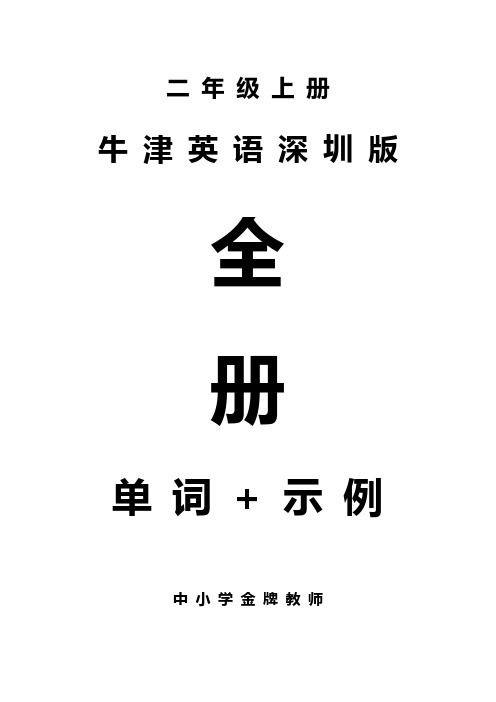
二年级上册牛津英语深圳版全册单词+ 示例中小学金牌教师Name:_____________Class:_______________沪教版深圳市小学二年级上册单词+例句表单元序号单词中文课文例句Unit11good好的Good morning.2evening晚上;傍晚Good evening.3night夜晚Good night.4day一天;一日Eddie's day5mum 妈妈Good morning,Mum.6today 今天Good afternoon,Eddie.How are you today?7very well 很好;非常好Good afternoon,Mum.I'm verg well.Thank you.8ant蚂蚁A for ant.B for bear.Ant,ant,ant.Bear,bear,bear.9bear熊Unit210tall高的Oh,you're tall.I'm short.11short矮的12boy 男孩I'm a boy.l'm tall.l'm thin.Who am I?13girl 女孩Hi,Eddie!l'm a girl.l'm short.l'm thin.Who am I?14no不;不是No.I'm Kitty. 15yes对Yes,I'm Tom. 16name名字nameUnit317sorry 对不起;请原谅sorry18seven七Seven and eight,draw a snake. 19eight八20nine九Nine and ten,do it again. 21ten十22elephant大象E for elephant.F for frog.Unit423swim 游泳Can gou swim,Danny?24run跑I can run. 25write书写;写字write26fly飞;飞翔I can fly.27ride a bicycle 骑自行车Can gou ridea bicycle?28can't不能;不会No!I can't fly.29giraffe长颈鹿The giraffe is tall.Unit530family家;家庭That's my family31brother哥哥;弟弟Is he your brother?32sister姐姐;妹妹Is she your sister?33friend朋友No.She's my friend.34young年轻的He's/She's...(old/young)35old 老的She's old.Is she tall?ls she thin?36insect昆虫The insect can fly.37jellyfish水母The jellyfish can swim. Unit638hair头发I'm Giant.My head is big.My hair is short.39head头My eyes are big.40your 你的You're supergirl.Your hair is long.Your eyes are big.I like you.41long长的42now现在l'm Giant now.Mg head is big.Mg hair is short.Mg eyes are big.43look 看Look.My hair is short.Your hair is long.44kangaroo 袋鼠K for kangaroo.L for lion.The kangaroo has a bia bag!The lion has bia head!45lion 狮子46has 有Unit747playground (学校或公园中的)游戏场In the playground 48slide 滑梯l can see a slide.49swing 秋千Ican see a swing.50seesaw 跷跷板l can see a seesaw.51nightingale 夜莺l can see a nightingale.Unit852room 房间In my room53put 放Put the book in the bag.54the (表示特指)55bag 包56dad 爸爸oK,Dad.57box 盒子;箱子Put the box on the chair.58on 在.....上59chair椅子60desk书桌Oh,no.Put the box on the desk.61car 小汽车Put the car on the desk,please.Put the books in the bag.please.Put the bear in the box,please.62look at看Look at your desk,Kitty.63pencil case 铅笔盒;铅笔袋Put the pencils in the pencil case.64ox公牛O for ox.P for pig.The ox works.The pig sleeps.65work劳动;干活66sleep睡觉Unit967dinner正餐;晚餐Dinner is ready68ready准备好69plate盘子;碟子A plate?70chopsticks筷子Chopsticks?71bowl碗How many bowls?72spoon匙;调羹How many spoons?73queen bee蜂王;蜂后The queen bee flies around.74fly around飞来飞去75run around 跑来跑去The rabbit runs aroundUnit1076sky天空In the sky77moon月亮Look!Can you see the moon?78bright 明亮的Yes.It's big.It's bright.79sun太阳Can you see the sun?80star星Look!Can you see the stars?103beautiful 美丽的Look at this flower.It's beautiful.104cry哭;哭泣Don't cry,Danny.105yak牦牛A fox,a yak and a zebra,In the zoo. 106zebra斑马。
深圳牛津版小学英语二年级下Unit6 Animals I like 精品
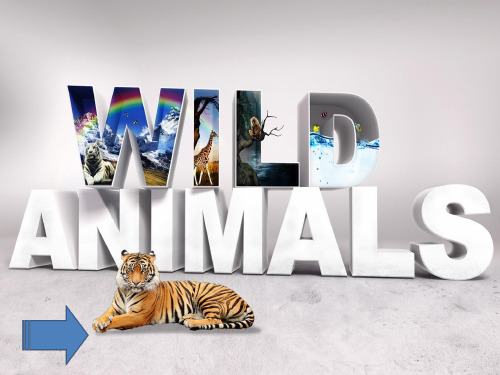
Hush 安静 my darling don‘t fear 不要害怕 my darling The lion sleeps tonight
Hush 安静 my darling don’t fear 不要害怕 my darling The lion sleeps tonight
A-weema-weh, a-weema-weh, a-weema-weh, a-weema-weh A-weema-weh, a-weema-weh, a-weema-weh, a-weema-weh
Near the village 村庄, the peaceful village The lion sleeps tonight Near the village 村庄, the quiet village The lion sleeps tonight
A-weema-weh, a-weema-weh, a-weema-weh, aweema-weh A-weema-weh, a-weema-weh, a-weema-weh, aweema-weh
a video
What Are They? Song – Fun Kids English
Hale Waihona Puke ANIMAL SOUNDS
GAME
Listen to the animal sound, and choose the correct animal.
It’s a ….
Yes / No
Let’s sing a song!
They’re toy snakes.
They’re toy snakes.
They’re snakes.
Next
They’re pigs
深圳二年级上册英语U7 In the playground
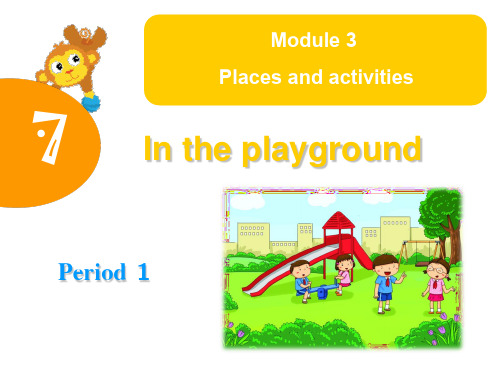
I can see a seesaw. It’s blue.
I can see a blue seesaw.
I can see a ______ seesaw.
What can you see, Danny?
I can see a seesaw. It’s blue . I like seesaw. Cool, cool, cool !
I can see a slide.
It’s red .
I like slide.
Fun, fun, fun !
Back, a swing. I can see. A seesaw, a swing. For you and me.
A ____, a _____. I can see. A _____, a _____. For you and me.
seesaw I can see a slide
swing
Module 4 TMheowduorleld3around us Places and activities
7
In the playground
Period 1
saw see
I can see, I can see. I can see a seesaw. I can draw, I can draw. I can draw a seesaw.
swing
Sept 1. Take out the piece of paper.
(拿出昨晚的预习作业)
Sept 2. Circle and create
(圈一圈,创造新的小语篇)
Sept 3. Say in your group.
(小组内说一说)
Unit 7 In the playground (Period 1) What can you see?
深圳牛津版小学二年级英语上册知识点汇总
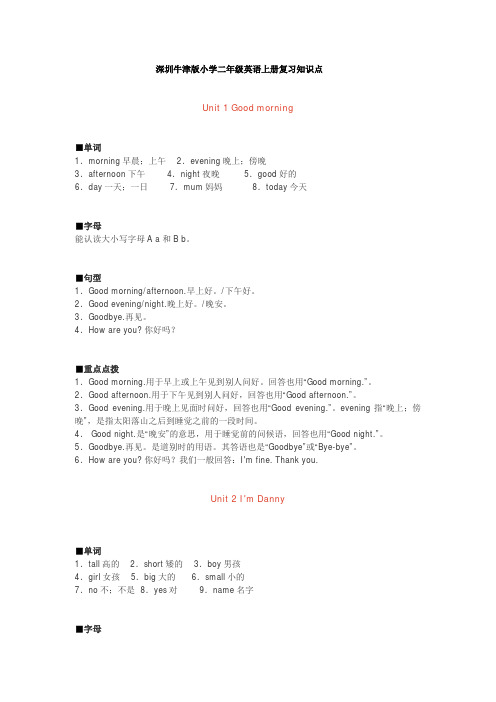
深圳牛津版小学二年级英语上册复习知识点Unit 1 Good morning■单词1.morning早晨;上午 2.evening晚上;傍晚3.afternoon下午 4.night夜晚 5.good好的6.day一天;一日 7.mum妈妈 8.today今天■字母能认读大小写字母A a 和B b。
■句型1.Good morning/afternoon.早上好。
/下午好。
2.Good evening/night.晚上好。
/晚安。
3.Goodbye.再见。
4.How are you? 你好吗?■重点点拨1.Good morning.用于早上或上午见到别人问好。
回答也用“Good morning.”。
2.Good afternoon.用于下午见到别人问好,回答也用“Good afternoon.”。
3.Good evening.用于晚上见面时问好,回答也用“Good evening.”。
evening指“晚上;傍晚”,是指太阳落山之后到睡觉之前的一段时间。
4. Good night.是“晚安”的意思,用于睡觉前的问候语,回答也用“Good night.”。
5.Goodbye.再见。
是道别时的用语。
其答语也是“Goodbye”或“Bye-bye”。
6.How are you? 你好吗?我们一般回答:I'm fine. Thank you.Unit 2 I'm Danny■单词1.tall高的 2.short矮的 3.boy男孩4.girl女孩 5.big大的 6.small小的7.no不;不是 8.yes对 9.name名字■字母能认读大小写字母C c和D d。
■句型1.I'm a boy.我是一个男孩。
2.I'm short.我很矮。
3.I'm big.我很大。
4.You're a girl.你是一个女孩。
5.You're small.你很小。
- 1、下载文档前请自行甄别文档内容的完整性,平台不提供额外的编辑、内容补充、找答案等附加服务。
- 2、"仅部分预览"的文档,不可在线预览部分如存在完整性等问题,可反馈申请退款(可完整预览的文档不适用该条件!)。
- 3、如文档侵犯您的权益,请联系客服反馈,我们会尽快为您处理(人工客服工作时间:9:00-18:30)。
Name:_____________like / likes1. My father _______ salty food. He eats lots of potato chips.2. My sisters ________ chilli fish and I ________ chilli fish too.3. We _______ potato chips but Sam ________ ice cream.4. My dogs _________ beef. They _________ fish too.5. Ben and I _______ raisins. Our sister ________ chocolate.6. Susan _______ hamburgers. She eats a hamburger for lunch every day.too much / too many1.Don’t drink __________ cola, Lily. It’s not good for you.2.There is ____________ food in the fridge.3.There are ___________ people in the swimming pool.4.Be a good child. Don’t eat _________ sweets.5.There are ___________ eggs in the basket,6.Here are some cheese rings. Don’t eat ________.7.Here is some chocolate. Don’t eat ___________.some1.He wants ___________________ (hamburger).2.Judy buys ___________________ (ginger).3.May I have _________________ (tea), please?4.Sue wants to buy _________________ (chilli fish).5.Do you want ___________________ (cookie).6.There are _______________ (cheese ring) in the packet.7.Look, Billy is eating _________________ (chocolate).8.Sue has _________________ (curry beef ball).9.Cindy wants to buy _________________ (peanut).10.There are _______________ (potato chip) in the packet.don’t like / doesn’t like like / likes 1. Paul ___________ potato chips.×He ___________ sour plums.√2. The children ___________ peanuts.×They ________ raisins.√3. Billy and I _________ cookies.√We __________ curry beef balls.×4. A: Does your sister_______ ginger?B: No, she_____________ ginger.×She __________ sweets.√5. A: Do you __________ sweets, John?B: No, I _____________ sweets.×I _____________ peanuts. √Name:_____________There is / There are1. There ___________ some sweets.2. There __________ some milk.3. _______________ an apple.4. _______________ some potatoes.5. _______________ some eggs.6. _______________some ham.Is / Are there ?1. A: ___________ any children in the park?B:Yes, ____________.2. A: ___________ any fruit at home?B: No, ___________. Please buy some.3. A: __________ any chocolate?B: Yes, __________. I know it’s your favourite snack. 4. A: ____________ any cookies?B: No, __________, but___________ some sandwiches.Do you want some?5. A: What do you want, Amy? B:________ any orange juice?A: Yes, ___________. Here you are.a an some anyA: I want to make _____ fruit cake. I need ______ fruit. Is there ______ fruit in the fridge?B: Yes, th ere is. There’s _____ apple, _____ orange and _______ bananas.A: Are there ________ grapes?B: Sorry. There aren’t ______grapes. I can go and buy some for you.A: Thank you. I also need ______ flour, ______ butter and _______ sugar.Is there ______ flour, butter and sugar?B: Yes, there is.Finish the sentences using to.catch drink have do eat go wash1.I want _______ my hands. Where are the toilets, please?2. It’s time __________ your English lesson.3. The dog wants ___________ some water.4. It’s time ___________ to bed, Sue.5. Do you want ___________ some cakes, John?5. The cat wants ____________ the bird.6. It’s time ________ your homework.1.Dan has a swimming lesson _____ twelve o’clock.2. A: Do you do your homework _____ the evening.B: No, I do my homework _____ the afternoon.3. My mother is a nurse. She goes to work _____ half past nine ______ night.Name:_____________It's ....1:25 ______________. 8:40 _______________. 4:15 ______________. 12:00 _______________. 2:30 _____________. 6:45 _______________. 6:10 ______________. 3:40 _______________. 5:50 ______________. 7:05 ______________. 2:20 ______________. 3:35 _______________. 9:55 _______________. 4:40 _______________.❖it is / they are❖there's / there are1. A: How many apples are there?B:_________ one apple.2. A: What's the time now?B: _______ six thirty._______ time for your music lesson.3. A: Are there any grapes, Mum?B: Yes, _________ some grapes in the fridge.4. A: Are there any birds in the park?B: Yes, ________ all lovely.Add s or es where necessary.1.Sam _______ (help) his mother at home every day.2. Jane _______ (make) the bed every morning.3. Lily and Eric _______ (wash) the dog in the afternoon.4. My brother ________ (do) his homework in the evening.5. The children ________ (help) their teacher at school.6. Mr Chan ________ (dry) the dishes every day.7. May ________ (tidy) the house in the morning.How do / does …?1.A:________ your father go to work?B: He ______ to work by minibus.2.A:________ you ______(come) to school?B: I ______ to school by school bus.3.A:______ you help at home, boys?B: We _____ the table.4.A:________ Billy go to the park?B: He _____ to the park on foot.5. A: ________ your sister help at home?B: She ______ the floor.Name:_____________❖Does Kate tidy her room?Yes, Kate tidies her room.1. __________________________Yes, the children like chili fish.2. __________________________Yes, Susan waters the plants.3. _____________________________Yes, Tim makes his bed every morning.4. ______________________________Yes, Bob and Bill tidy the living room.5. ____________________________________Yes, Mrs Lee washes the clothes in the evening.like→ likesget ________ make _______ invite ________ want _______ water_______ take _________ see ________ read_______ play_________ set ________ sweep_______ help_________ 特殊单词变化:have________ do _________ go ________ wash ________ brush _______ tidy _______ dry _________Who How How about How many What1. I help my mother every day.________________ you, Cindy?2. A: _______'s the time?B: It's ten thirty.3.A: _____ does your sister help at home, Paul?B: She waters the plants.4. _______helps at home, children?Hands up.Good. All of you help at home.5.A: ___________ of your classmates help to wash the dishes at home?B: One.6.________ pupils help at home? Four.7._____ do you help at home? I wash the dishes.8.________ you, John? I set the table.9._____ waters the plants? Jenny.10._______ the time? One o'clock.用not改写单词1. like—_do not like2. likes—___________3. play—_________4. plays—__________5. tidy—_________6. tidies—__________Name:_____________don’t / doesn’t1.I help at home in the evening.___________________________2. Charlie washes the dishes.___________________________3. Gary likes playing all gamers.___________________________4. Mike and Jack join the Tennis Club.___________________________用and / but完成句子1.I like playing volleyball ________ basketball.2.Susan likes potato chips ____ she does not like fries.3. Billy likes running _______ I no not.4. Tim likes table tennis _____ Tina likes table tennis too.5. I do not like swimming _____ I like going to the beach.6. A table tennis ball is small ____ light ____ abasketball is big ______ heavy.改写句子.注意首字母大写,和标点。
